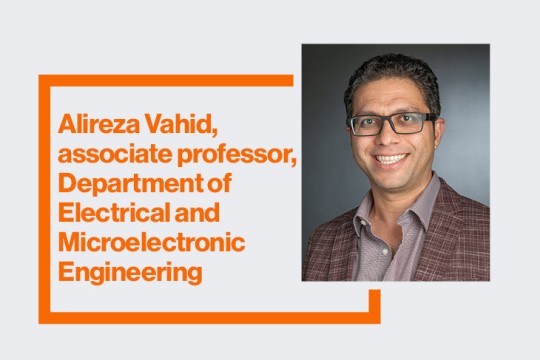Nanotechnology Education at RIT Could Become National Model
Curriculum emphasizes the scientific, ethical and societal impact of nanotechnology
The next generation of engineers and scientists will grapple with issues in nanotechnology that would seem incredulous by today’s standards. Applications as fantastic as nanostructures created to eat oil spills or wearable sensor devices that detect gases will have wide consequences both intended and unintended.
Rochester Institute of Technology is educating the next generation for the “next new thing” that has yet to arrive.
RIT is among a handful of universities in the United States developing coursework in nanotechnology education to train students in the scientific, ethical and social dimensions of this emerging technology. The university recently won a $100,000 grant from the National Science Foundation to create an interdisciplinary pilot concentration to gauge the implications of the new world of nanotechnology—or its “promises and perils,” says Paul Petersen, special assistant to the provost at RIT and project leader.
“We’re trying to avoid the hype,” Petersen says. “We want students to understand the technology and what it could do and what it might do.”
Petersen worked with College of Liberal Arts (CLA) endowed chairs Diane Hope, the William A. Kern Professor in Communications, and Wade Robison, the Ezra A. Hale Chair in Applied Ethics, to develop three freshman/sophomore-level classes focusing on nanotechnological issues. The CLA pilot concentration will be open to 25 students in the first year and up to 125 students in the second year.
“This ground-breaking course sequence will put RIT at the forefront of colleges and universities exploring the social and ethical implications of nanotechnology, along with the underlying science and technology,” says Stanley McKenzie, provost and vice president for academic affairs at RIT.
The pilot sequence will begin in the winter academic term with an in-depth analysis of nanotechnology principles and related ethical issues led by Robison and Petersen. The second course, facilitated by Petersen in the spring quarter, will give students hands-on laboratory experience. The sequence will wrap up in fall 2004 with discussions of potential applications and related societal effects led by Hope and Petersen. Each class will feature experts from the field.
The series of courses will serve as a national model for other universities to follow to strengthen interdisciplinary research and education in nanotechnology.
Robison points to Dolly, the infamously cloned sheep that shocked the world. “We’re going to wake up one day and discover that someone has done something quite unique and exciting, and dangerous.”
“One concern is that researchers don’t produce something that fundamentally alters our physical world,” Robison says. “It’s awkward to raise this issue because it’s like crying wolf—Be careful because you might do something. We have no way of projecting precisely how nanostructures will behave. We are working with new concepts and systems.”
Hope is specifically interested in the impact on the environment and health, and how applications of nanotechnology will affect marginalized groups, specifically women and the poor.
“We want students to see all sides of this issue as it develops,” she says. “We hope a close examination of the issues will provide balance and inspiration for careers in science and engineering, and for active citizenship in the general public.”
Internationally recognized as a leader in computing, imaging, technology, fine and applied arts, and education of the deaf, Rochester Institute of Technology enrolls 15,500 students in more than 340 undergraduate and graduate programs. Its cooperative education program is one of the oldest and largest in the nation.
For the past decade, U.S. News and World Report has ranked RIT as one of the nation’s leading comprehensive universities. RIT is also included in Fisk’s Guide to America’s Best Colleges, as well as Barron’s Best Buys in Education.














